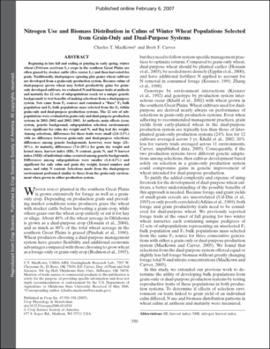| dc.contributor.author | MacKown, Charles T. | |
| dc.contributor.author | Carver, Brett F. | |
| dc.date.accessioned | 2015-10-16T20:47:50Z | |
| dc.date.available | 2015-10-16T20:47:50Z | |
| dc.date.issued | 2007-02-06 | |
| dc.identifier | okds_Carver_CS_2001-02-06 | |
| dc.identifier.citation | MacKown, C. T., & Carver, B. F. (2007). Nitrogen use and biomass distribution in culms of winter wheat populations selected from grain-only and dual-purpose systems. Crop Science, 47(1), 350-358. https://doi.org/10.2135/cropsci2006.05.0318 | |
| dc.identifier.uri | https://hdl.handle.net/11244/19797 | |
| dc.description.abstract | Beginning in late fall and ending at jointing in early spring, winter wheat (Triticum aestivum L.) crops in the southern Great Plains are often grazed by stocker cattle (Bos taurus L.) and then harvested for grain. Traditionally, dual-purpose (grazing plus grain) wheat cultivars are developed from a grain-only production system. Because culms of dual-purpose grown wheat may forfeit productivity gains for grain only developed cultivars, we evaluated N and biomass traits at anthesis and maturity for 12 sets of subpopulations (each set a unique genetic background) to test benefits of making selections from a dual-purpose system. Sets came from F2 sources and contained a "Base" F3 bulk population and F5 bulk populations mass selected from the F2 within grain-only and dual-purpose production systems. The 12 sets of subpopulations were evaluated in grain-only and dual-purpose production systems in 2001-2002 and 2002-2003. At anthesis, main effects (year, system, genetic background, subpopulation selection environment) were significant for culm dry weight and N, and flag leaf dry weight. Among selections, differences for these traits were small (2.0-3.5%) with no difference between grain-only and dual-purpose selections; differences among genetic backgrounds, however, were large (21-30%). At maturity, differences (7.6-20%) for grain dry weight and kernel mass, harvest index (HI), N content, grain N, and N harvest index (NHI) of individual culms occurred among genetic backgrounds. Differences among subpopulations were smaller (1.4-4.5%) and significant for only culm and grain dry weight, kernel number and mass, and culm N content. Selections made from the dual-purpose environment performed similar to those from the grain-only environment when grown in either production system. | |
| dc.format | application/pdf | |
| dc.language | en_US | |
| dc.publisher | Crop Science Society of America | |
| dc.rights | This material has been previously published. In the Oklahoma State University Library's institutional repository this version is made available through the open access principles and the terms of agreement/consent between the author(s) and the publisher. The permission policy on the use, reproduction or distribution of the material falls under fair use for educational, scholarship, and research purposes. Contact Digital Resources and Discovery Services at lib-dls@okstate.edu or 405-744-9161 for further information. | |
| dc.title | Nitrogen use and biomass distribution in culms of winter wheat populations selected from grain-only and dual-purpose systems | |
| osu.filename | okds_Carver_CS_2001-02-06.pdf | |
| dc.description.peerreview | Peer reviewed | |
| dc.identifier.doi | 10.2135/cropsci2006.05.0318 | |
| dc.description.department | Plant and Soil Sciences | |
| dc.type.genre | Article | |
| dc.type.material | Text | |
